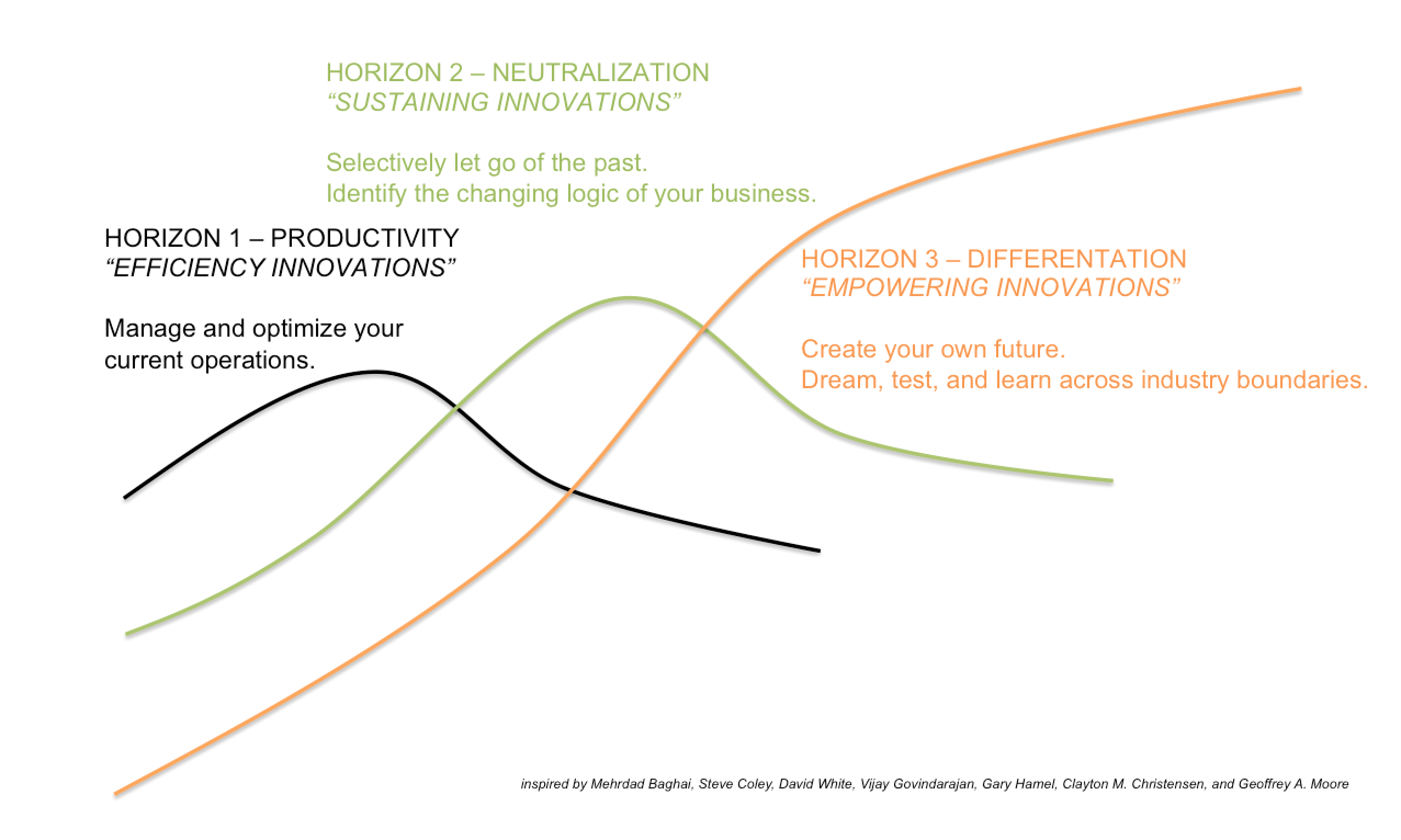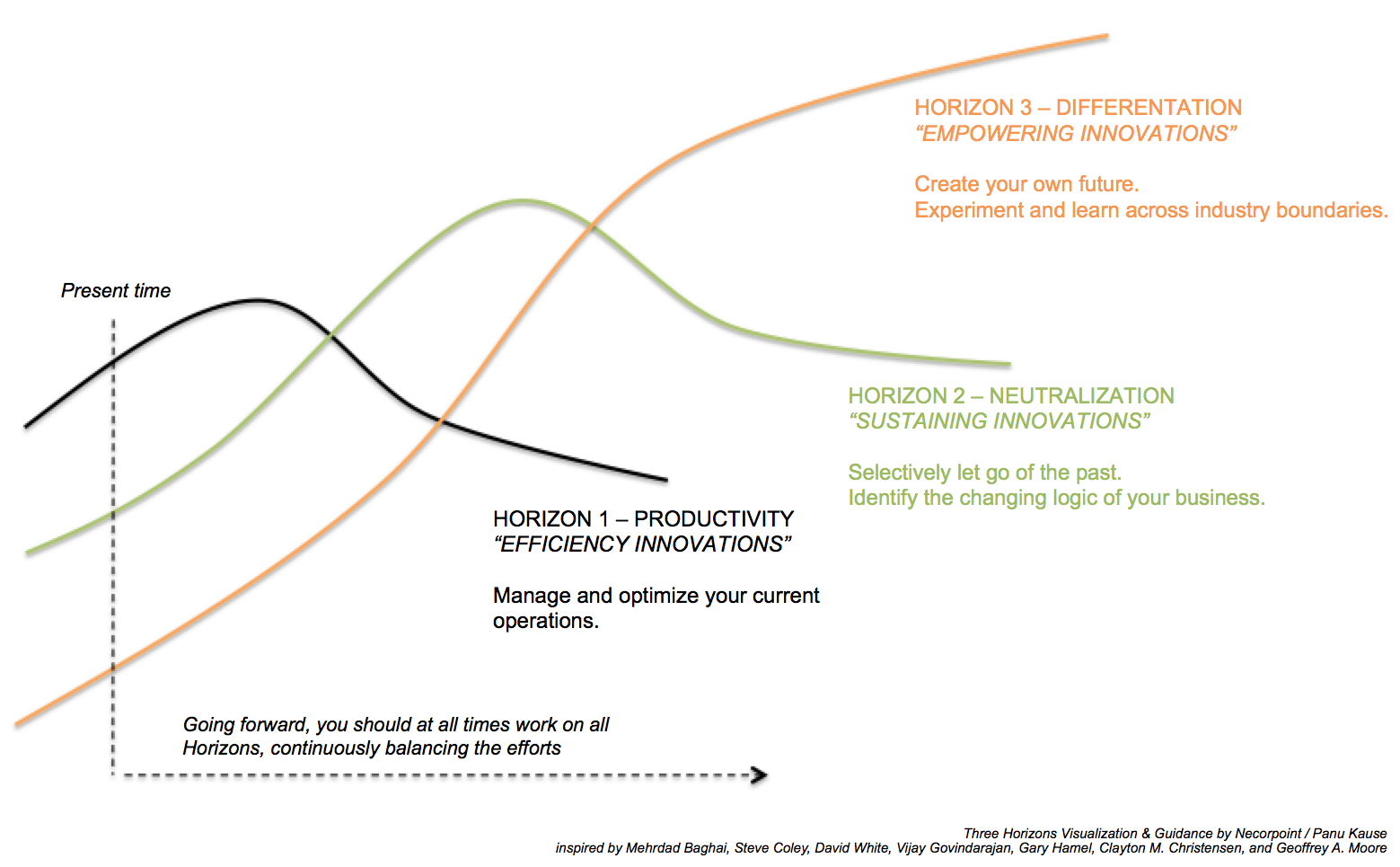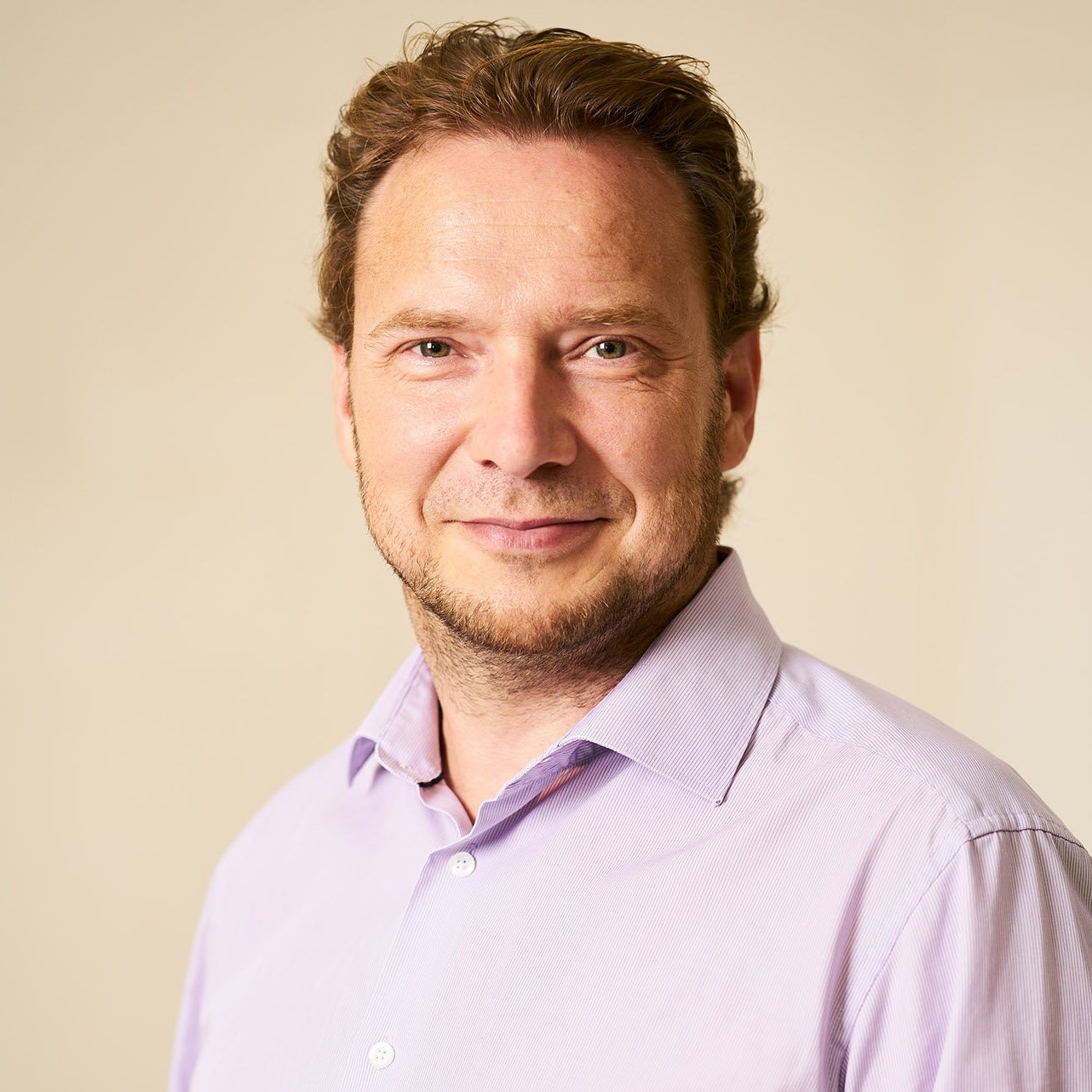Using the three horizons framework for foresight

Continuous renewal is a necessity. While one might argue differently for any one company, the statistics are brutal as summarized in this Harvard Business Review article based on research by Vijay Govindarajan and Anup Srivastava: the rate of corporate death due to sticking with "business-as-usual" is really, really high.
The whole point of the Three Horizons Framework is to systematically - and concurrently - work with the current "bread and butter", with the next wave of your emerging business, and with even the longer perspective where many futures and opportunities are plausible.
Now, then, one of the key questions, of course, is how to plan for working with these three different timelines. You need to organize the work between them, keep them reasonably independent, but at the same time, aligned enough and manage it all.
In this blog post, I will share my experiences on systematic renewal work using the horizons.
What is the Three Horizons Framework?
There's nothing really groundbreaking about the Three Horizons. The basic concept was first featured in Alchemy of Growth (Baghai et al) already in the late 1990s. Thinking quite similar to mine has been published even by McKinsey&Company almost a decade ago.
What I think, in addition, is that many strategy, innovation, and management models by giants such as Vijay Govindarajan, Gary Hamel, Clayton Christensen, and Geoffrey A Moore, and others, are in parallel to the concept of the Three Horizons. I've just taken the simplest parts of all these ideologies and built a compilation for myself that seems to add value in many environments.
What is remarkable is that not too many organizations really work with all of the Three Horizons. Let me explain. At least I wish to use "my version" of the Three Horizons for a very simple and straightforward concept:
Horizon 1
You need to continuously optimize your current business operations in order to keep them competitive and profitable.
Horizon 2
At the same time, you have to identify new ways of doing business - "the next mainstream", one might say - and develop new offerings and operations correspondingly.
Horizon 3
At the same time, you must explore and experiment across industry boundaries and beyond what is currently possible, in order to stay relevant in the long run.

A Recipe for Success: Being Able to Work on All Three Horizons at the Same Time
The real challenge here is the call for working on all those Horizons concurrently. This requirement brings in major implications, such as:
- How to offer real guidance to your strategy execution, i.e. how to proactively set rules for allocating resources to the different Horizons?
- How should you organize for each of the Horizons, understanding that all those require different leadership and competence?
- Even in terms of financials only, what should be the business criteria for working with the different Horizons, understanding that corporate overhead or pay-back expectations for Horizon 1 would severely discriminate Horizon 2 and Horizon 3 if applied
- With regard to Horizon 1, how to keep people motivated if your grand vision clearly relates to Horizon 3 like it should?
- In practical terms, how to arrange for learning of experiments related to Horizon 3 that might be even fed into Horizon 1?
- How to ensure scaling of Horizon 2 new offerings or Horizon 3 experiments when the time is right (and how to know when the time is right)?
Where Project Portfolio Management Fails
Corporations tend to organize for something called project portfolio management to keep their development efforts transparent, prioritized, and systematic. I've worked on dozens of such endeavors and trained a couple of thousand people on the topic. I've even posted some more thoughts about this at Aalto Leaders' Insight (apologies, this article is in Finnish only).
Long story short, I do know steering/management structures such as project portfolio management can be really beneficial.
What's more, I also know the majority of organizations fail to exploit project portfolio management to its full potential. Most portfolio management setups tend to miss the proactive nature of business planning and steering, and, thus, fail to run development along with the Three Horizons.
Project portfolio management oftentimes becomes reactive, while solving prioritization and/or resource allocation conflicts between the ongoing projects and new project candidates, for example. Nothing really wrong with that, it's just that this rarely helps in keeping your "eyes on the big picture".
The Financial Aspect: How Much Budget to Allocate to Each Horizon?
Very simply put, I think your strategic plan should proactively set an ideal allocation of funds and other resources for the three Horizons. In project portfolio management terms, you'd need to proactively set the targeted balance for your portfolio, perhaps called 'the ideal portfolio'. In practical terms, but for illustration purposes only, you might then have three different types of projects in your portfolio, such as
- 'optimization projects' to enhance the competitiveness of your current operations on Horizon 1 (today's bread and butter); allocation target 70% of all resources
- 'development projects' for introducing new services, products, partnerships - and whatnot - for your emerging new businesses and/or business models of the Horizon 2; some of these might even include discontinuing current Horizon 1 offerings; allocation target 25% of all resources
- 'research and/or experimentation projects' to work for the longer future, i.e. Horizon 3; allocation target 5% of all resources

Systematically following up on your efforts, you will soon realize that your current portfolio would never be in that target balance. Thus, decision-making over project prioritization, new project candidates, resource re-allocations, and so on, would then be based on steering the portfolio balance closer to the pre-set, ideal balance. This, of course, would not be the only decision-making criterion, even if it would be the most strategic one.
Obviously, project portfolio management is not a prerequisite for working with the Three Horizons Framework. On the contrary, having all projects in one portfolio and perhaps even working with them in one line organization might be a show-stopper for real innovation.
The Three Horizons Framework is applied in many, different-sized organizations - it's versatile, even we use it. That's what inspired me to write few thoughts about it in the first place. As it goes that for us, the first half of the year has been about building our very own path even for Horizon 3 (have a peek here).
The Organizational Aspect: Which People Should Work on Each Horizon?
In this third and final part, I'll now elaborate a bit more on the human side of executing those strategic Horizons. How to balance the skillset of people, competence, and motivation, with the different Horizons and with the long-term vision? What are some of the practical organizational and cultural aspects to consider?
Not long ago, I had a chat with my colleagues about this: how do you organize the work for the different Horizons. It just happens to be so, that it is very hard - if not impossible - to have the same people working on the different Horizons. Why? Well, Horizon 1 is about running the current business as efficiently as possible. Horizon 3 for example, in turn, is something that has little to do with how things are currently run. It's more about quick experimentations, trials, and errors, seeking, searching, and learning. These Horizons have very different velocities, different cycles of the impact, different learning curves.
It also comes down to capabilities, skills, and individuals' desires. Depending on how far you are reaching (which Horizon you are working on), you need a different set of skills and a different mindset. It is rare that the same people can, or even want, to be part of all Horizons at a given time.
In terms of organizational setup then, what to do? Again a rough oversimplification, just to state my case: consider keeping the different Horizons separate even in your organizational structure. Horizon 1 would be the process-optimizing efficient line organization, Horizon 2 perhaps a business development function, and Horizon 3 perhaps led via autonomous innovation programs and/or skunkworks. This ensures a steady working environment for the current quality and efficiency-focused operations (Horizon 1), while simultaneously giving room for creativity within the far-reaching Horizon 3 endeavors.
Many organizations, of course, look outside their own organization for added support of the new futures, because the skills and management required will be so different. Nothing wrong with that. I've repeatedly argued that there are some 7,5 billion people outside of your organization, and many of them are pretty smart.
The Cultural Aspect: How to Set Goals For Each Horizon?
While building the capabilities for working on the different Horizons, and especially if you still decide to build the teams within your existing organization, communication about the why and how is key. There are stories of organizations that haven't fully realized this, and subsequently caused a lot of questioning.
Ultimately, ending up hindering the progress rather than accelerating it. Once again, it will be very different working on those Three Horizons. Needs will be different, tools and methods are different, people are different, expectations are quite different indeed.
For a very simple illustrative example: if your job is to make sure that the customers of today are served properly, you simply can not concentrate on something that might happen in 15 years' time. Unless you then fully understand the difference between Horizon 1 and Horizon 3 - and the high importance of both - it may also be hard to accept some of your colleagues having their feet off the ground, talking about loose visions and experiments only.
The different Horizons share a common target, but they have a very different role in building the path towards that target. Let people know that.
A Leader's Checklist For Implementing the Three Horizons Model
Whether you are a CEO, COO, CIO, or VPX, consider these at least:
1. Don't get stuck on what is possible now
Not everyone in your organization (or in your management team) needs to be a futurist or an innovator. Of course, you all can still broaden up your thinking e.g. via these great questions by The Fast Company. Don't get stuck on what is possible NOW. Look past that. Stay curious. Enable that foresight and futures thinking, encourage it.
2. Build separate teams or businesses for different Horizons
It might be a good idea to build separate teams or even separate businesses for focusing on the different Horizons. One more practical consideration: perhaps the current business organization needs to be the owner of all support functions, whereas a free-of-corporate-overhead Horizon 3 unit only acquires selected services from them. This way, even if not fully a skunkworks model, the future-oriented guys only get to acquire what they need, and the current business can concentrate on being efficient.
3. Consider think-tanks, hubs, and accelerators
Establish, or be part of think-tanks, hubs, accelerators, and so on, if possible. Or maybe you are in a position to start one up within your own organization? Hubs and such can be a very easy ground for quick trials and pilots. Be careful, though. Not all people who are interested in such work should participate in such work. For one, Horizon 3 especially is also about new types of risk, and I think this risk should also be present for the people. It comes down even to different compensation models.
4. Welcome all outcomes openly
Always be aware that the concrete outcomes of the work along the different Horizons are very different. Be ready for some open discussion. You might also be looking at a situation of abandoning your current business altogether in the end, which will bring in very tough questions.
5. Look for the disruptive changes in your business environment
Do keep your finger on the pulse at all times. Once you've set your first set of the framework for Horizons, you need to constantly realign, and check the direction is continuously valid. Look out for those wild and fast, often disruptive changes in your business environment. Remember that it is about building foresight, it is never about precise predictions of the future.
For Inspiration and Further Reading
McKinsey wrote in 2015 about tips on how to lead through the change - this becomes relevant when the steps between the Horizons are being planned and done.
How to keep all the Horizons as a true part of your organization and culture, or not to too much "isolate" them, you might consider this article by Inc: "If you outsource your innovation efforts, you will end up with concepts that will not be accepted by your existing culture". That surely is something to consider, but the question here is again, which Horizon are you building, and how and when will your Horizons 2 and 3 become mainstream.
This Forbes article, in turn, outlines why building a community around the Horizons work could be an asset. In a way it's pretty simple, providing the common target for each Horizon.
Harvard Business Review writes nicely about how to manage a multi-party innovation ecosystem (might require a login).
And lastly, why is it important to take risks? Especially in a product-based market, this Forbes article nicely demonstrates what many of us know: "if you don't make your product obsolete - someone else will". Being a game changer means you have to be bold...
Finally, feel free to have a peek at my presentation for CEIBS (China Europe Business School) in November 2016, under the topic 'Business Models: Trends and Transformations in Finnish Companies'. Thinking behind these is also based on the Three Horizons framework:
English version
Chinese version
Photo by Martin Adams on Unsplash

Panu Kause is the founder and CEO at FIBRES. Before founding FIBRES, he held several management positions and ran his own foresight and strategy focused consultancy.
Stay in the loop
Get our latest foresight tips delivered straight to your inbox. You may unsubscribe from these communications at any time.
